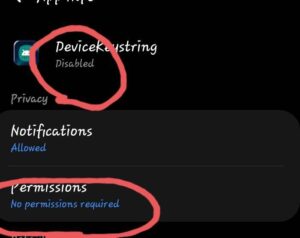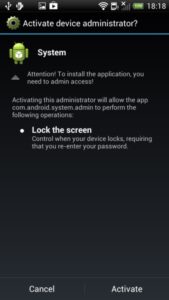What Is Devicekeystring App on Android Phones in 2024 and What Can It Do?
Welcome to the world of device keystrings
As Android users, we have a myriad of apps and services on our devices, but we tend to overlook many. They have a rather obscure but fairly common feature: the Device Keystring. If you’ve ever skimmed through your Android system apps, you’ve probably come across this post. But what exactly is this “Device Keystring” app, and why is it important in 2024?
Device Keystring is a system application, which plays silently in the background and manages key strings or commands that control the operation of your phone. While most people rarely interact with it directly, the app plays an important role in our daily mobile experiences. Recognizing the importance of such small things and letting go can help unlock new knowledge about our Android devices.
To understand the device keystring
What is Device Keystring?
The Device Keystring app plays a key role in the bustling world of Android devices but remains under the radar for most users. But what is it? Think of the Device Keystring as a silent orchestra conductor, precisely and discreetly directing your smartphone’s many features and commands.
The value of the device keystring
Basically, the Device Keystring app does:
- Manage the sequence of commands, or ‘keystrings’, that control phone functionality.
- Facilitate communication between user actions and device feedback.
- To ensure that certain hardware button combinations result in specific actions.
Imagine pressing the volume key twice to start the camera. That’s the Device Keystring app in action, interpreting your commands and making your experience seamless.
The Role of Device Keystring in 2024
In 2024, the Device Keystring app on Android phones has taken on a pivotal role, streamlining how users interact with their devices on a day-to-day basis. Let’s dive deeper into its functions, responsibilities, and overall impact on the Android experience.
Main Functions and Responsibilities
Command Execution
- Hardware Control: Allows users to perform specific actions like taking screenshots or launching the camera with simple hardware button sequences.
- Software Control: Enables activation of certain software functions, such as turning on flashlight mode or initiating a voice recording, through predefined commands.
Interaction with Other Applications
- Enhanced Device Management: Works behind the scenes to ensure smooth operation between various apps and system components, contributing to a seamless user experience.
- Customization and Control: Offers users the ability to customize certain aspects of their device’s behavior by modifying keystrings, tailoring the device to their personal needs and preferences.
Impact on Daily User Interaction
The Device Keystring app operates silently, yet it significantly influences how we use our Android phones. Here’s how:
- Streamlining Operations: By handling a variety of commands and functions, Device Keystring reduces the need for navigating through multiple menus, making device operation quicker and more intuitive.
- Facilitating Accessibility: For users with physical limitations, keystrings can be a game-changer, making many device functions more accessible with less effort.
Examples of Daily Impact
- Quick Actions: Snapping a photo by double-pressing the power button when your device is locked.
- Accessibility Features: Enabling a specific function by a simple gesture or button press, tailored to assist users with varying needs.
- Seamless Transition Between Apps: Efficiently managing background processes to ensure smooth app usage without manual intervention.
Key Features of Device Keystring App
The Device Keystring App, a subtle yet powerful tool within Android devices, has evolved significantly in recent years. Let’s explore the advanced features, security components, and customization options that stand out in the latest updates.
Advanced Features Introduced in Recent Updates
Enhanced Compatibility
- Cross-Device Synchronization: Allows users to maintain consistent keystring settings across multiple devices.
Improved Functionality
- Contextual Command Execution: Recognizes the context in which a command is given, adjusting its response accordingly.
- Gesture-Based Commands: Incorporates physical gestures as part of the command options, broadening the ways users can interact with their devices.
Security Features
- Command Encryption: Safeguards the commands and gestures configured by the user, ensuring that they cannot be intercepted or duplicated by malicious entities.
- Secure Access: Implements measures to ensure that only authorized users can modify keystring settings, adding an extra layer of security to device management.
Custom Command Creation and Management
- Intuitive Interface: Users can easily create, modify, or delete custom commands through a user-friendly interface.
- Command Testing: Provides a sandbox environment for users to test new commands before activating them, ensuring they work as expected.
User Control and Customization Options
The Device Keystring App empowers users with extensive control and customization options:
- Personalized Settings: Users can tailor their device responses to specific commands, aligning device functionality with personal preferences and usage patterns.
- Accessibility Enhancements: Offers customizable commands for users with accessibility needs, ensuring that everyone can navigate their devices efficiently.
Examples of Customization
- Personal Security Commands: Setting up a keystring that immediately locks the device or sends a distress signal when triggered.
- Efficiency Shortcuts: Configuring gestures or button sequences to launch frequently used apps or settings, reducing the time spent navigating through menus.
Benefits and Potential Drawbacks of the Device Keystring App
The Device Keystring App on Android has significantly influenced how users interact with their devices, delivering a mix of improved performance, enhanced security, and personalized control. However, like any tool, it comes with its own set of challenges. Below, we present a balanced overview, highlighting both the benefits and potential drawbacks of using the Device Keystring App.
Benefits of Using Device Keystring
Improved Phone Performance
- Quick Access: Facilitates fast access to apps and settings, reducing the time users spend navigating through their phones.
- Efficient Operation: Streamlines device operation with customized commands, enhancing the overall user experience.
Enhanced Security Measures
- Secure Commands: Protects personal settings and commands through encryption, preventing unauthorized access.
- Customizable Access: Allows users to set up unique commands for emergency situations, adding an extra layer of personal security.
Potential Drawbacks or Issues
Despite its advantages, the Device Keystring App may not be without issues:
Compatibility Issues with Some Android Models
- Limited Access: Not all Android devices support the Device Keystring App, which can limit user access to these features.
- Varied Experience: The performance and availability of certain features might vary between different models and manufacturers, affecting consistency.
Complexity for Average Users
- Steep Learning Curve: The customization and creation of new keystrings may appear daunting to less tech-savvy users.
- Overwhelming Options: The abundance of options and settings can potentially overwhelm users, making it difficult to utilize the app to its full potential.
Device Keystring and Android Compatibility in 2024
As technology evolves, ensuring that your Android device is compatible with the latest software features is key to maximizing its potential. The Device Keystring App is a modern tool designed to enhance user interaction with their device through customized commands. Here, we shall explore its compatibility with various Android versions and models in 2024 and outline how you can check if your device is ready for the latest keystring functions.
Compatibility with Android Versions and Models
Access to the Device Keystring App and its features may vary depending on your device’s model and the Android version it’s running:
- Newer Devices: Typically, the latest Android models come with the Device Keystring App pre-installed or available for download.
- Older Models: Owners of older devices may need to update their operating system to access the most recent keystring features.
Checking Device Compatibility
Here’s a simple guide on how to check if your Android phone supports the Device Keystring App:
- Update to the Latest Software:
- Go to ‘Settings’ on your phone.
- Scroll to ‘System’ and tap on ‘System Update’.
- If an update is available, follow the prompts to download and install.
- Check the Preinstalled Apps:
- Look through your device’s app drawer.
- Search for “Keystring” or related terms.
- Visit the Google Play Store:
- Use the Play Store search function, type in “Device Keystring App”.
- The app listing should specify compatible devices.
- Consult Manufacturer’s Website:
- Occasionally, the device manufacturer’s website will list compatible apps and features for each model.
Summary: Ensuring Compatibility and Access
To use the latest keystring functions, it is essential to:
- Own a recent Android model or update your older device.
- Explore preinstalled apps or the Google Play Store for the Device Keystring App.
- Double-check with the manufacturer’s information for precise compatibility details.
How to Access and Manage Device Keystring on Your Phone
Integrating Device Keystring functionality into your daily phone use can enhance usage efficiency and customization. The following is a straightforward guide to access and manage Device Keystring on your Android device, as well as advice on troubleshooting common problems.
Accessing Device Keystring Settings
To begin utilizing the Device Keystring App on your Android phone, follow these steps:
- Locate the App Settings:
- Open the ‘Settings’ application on your phone.
- Scroll down and select ‘Advanced Features’ or a similar category.
- Find the Keystring Option:
- Within ‘Advanced Features,’ look for ‘Device Keystring’ or ‘Keystring Commands’.
- If not found there, it might be within ‘Accessibility’ or ‘Developer Options’, depending on your phone model.
- Enable Keystring Features:
- Once you find the Keystring settings, toggle them on to activate the functionalities.
Interacting with Device Keystring
After activation, customize keystrings to fit your needs:
- Set Up Custom Commands: Create shortcuts for frequent actions, like opening a specific app or controlling device settings.
- Use Predefined Keystrings: Familiarize yourself with default keystrings that may already be programmed into your device.
Troubleshooting Common Issues
If you encounter issues, these steps might resolve them:
- Restart Your Device: Sometimes, simply restarting can help implement new settings.
- Check for Updates: Ensure your device’s software is up-to-date with the latest version.
- Reset App Preferences: If all else fails, reset your app preferences but beware that this will revert all default apps settings.
Summary: Practical Device Keystring Advice
Leveraging keystring functions involves:
- Activating the feature through the ‘Settings’ application.
- Customizing and using keystrings to streamline your phone usage.
- Addressing common issues with simple troubleshooting methods.
conclusion
To recap, accessing and managing Device Keystring settings can greatly improve your Android experience by customizing your device to the way you want to use it.
The Device Keystring App is another tool that provides:
- Improved productivity: Allows you to perform repetitive tasks faster.
- Customized connections: Tailor your device controls to your specific needs.
By finding and understanding Device Keystring, Android users can use their devices to unlock new business and personal features, making the technology work smarter for them.



